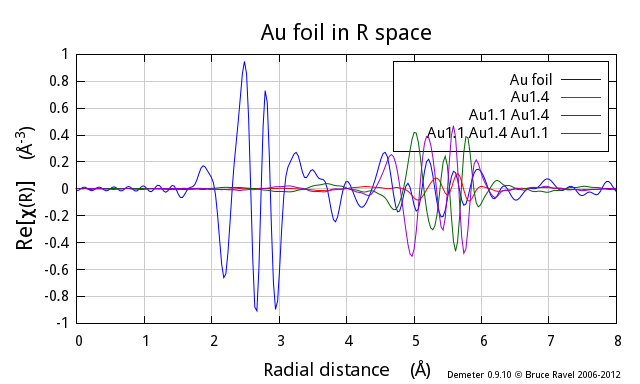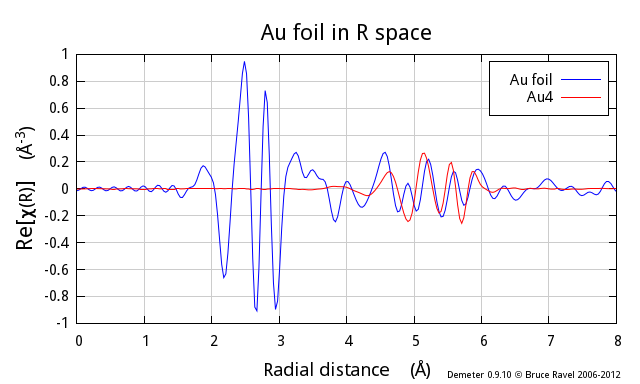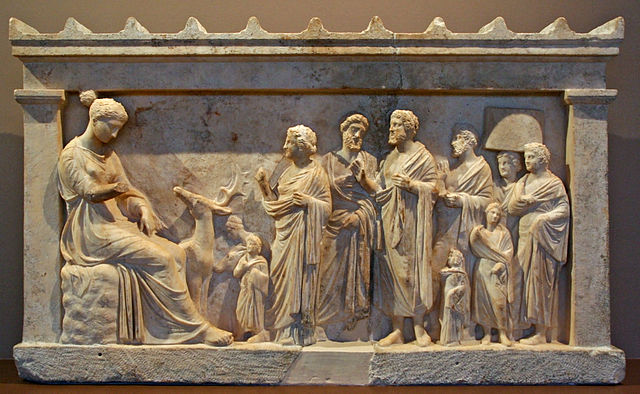5.3. Marking and Plotting¶
The check buttons next to each path in the path list are central to
many features in ARTEMIS related to plotting and other
tasks. Along with all of the tools in the Mark menu, you can mark a
group of paths by  clicking elsewhere on the path
list while holding down the Shift key. Doing so marks all
paths between the selected one and the one
Shift-
clicking elsewhere on the path
list while holding down the Shift key. Doing so marks all
paths between the selected one and the one
Shift- clicked upon.
clicked upon.
Todo
Write a page about tools for building MDS fits
5.3.1. Moving paths to the Plotting list¶
ARTEMIS has no special plot types involving individual paths like those for the data sets. Any plots with paths are constructed using the Plotting list on the Plot window. There are three ways of moving individual paths to the Plotting list.
- The blue button with the squiggly line in the upper left corner of
the Path page –
 – transfers that path to
the Plotting list.
– transfers that path to
the Plotting list. - A path will be transferred automatically after a fit if its Plot after fit button is checked.
- The set of marked groups will be transferred when is selected or Alt-Shift-T is used. This is probably the most common way of constructing plots involving many paths.
ARTEMIS offers a concept called a “virtual path”, or a “VPath”. A VPath is an ensemble of normal paths which are summed. The sum is then plotted in k-, R-, or q-space. A VPath is made by marking a set of paths then selecting . VPaths are discussed in more detail the chapter on the Plot window.

Fig. 5.9 Data on a gold foil plotted as Re[ χ(R)] with the fourth shell single scattering path and the two colinear multiple scattering paths involving the fourth neighbor and the intervening first shell neighbor. This is a rather cluttered plot due to the phase relationship between these three paths.
When the VPath is created, it is placed in the VPath tab in the Plot window and in the Plotting list. The VPath list contains tools for renaming and discarding VPaths, displaying its constituants in the Main window status bar, and a VPath onto the Plotting list. (Remember that, unless the Freeze button is clicked, the Plotting list is cleared and repopulated after each fit.)
5.3.2. Phase corrected plots¶
When the Data page button labeled Plot with phase correction, plots using that data set and/or any of its paths will be plotted with phase correction. This means that the contributions of the central and scattering atom phase shifts will be removed before the Fourier transform. This has the effect of shifting the peaks in χ(R) by about -0.5 Å, such that the first shell peaks at an R value close to the physical interatomic distance between the absorber and first shell scatterer.
The phase information is taken from one of the paths. Each path has a button labeled Use this path for phase corrected plotting. These buttons are exclusive – only one path per data set can have its button ticked on. The phase information from that path is used for the phase corrected plots.
If you turn on phase corrected plotting without having selected a path to use, ARTEMIS will issue a warning in the status bar and turn phase corrected plotting back off. You must select a path to use as the source of the phase information.
Note that, when making a phase corrected plot, the window function in R is not corrected in any way. The window is plotted using the R-range of the fit. If you change the R-range so that the window lines up with the phase corrected plot, you must remember to change it back before making a new fit or making a plot in q-space.
Also note that the phase correction propagates through to χ(q). While the window function will display sensibly with the central atom phase corrected χ(q), a “kq” plot will be somewhat less insightful because phase correction is not performed on the original χ(k) data.
DEMETER is copyright © 2009-2016 Bruce Ravel – This document is copyright © 2016 Bruce Ravel
This document is licensed under The Creative Commons Attribution-ShareAlike License.
If DEMETER and this document are useful to you, please consider supporting The Creative Commons.

